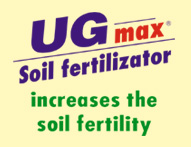The crop residue remaining in soil is a store of pathogens. It's accelerated decomposition limits the occurrence and development of many diseases.
In the wheat growing, the investigation carried out in 2005 by the Bydgoszcz Technical and Agricultural Academy Phytopathology Chair showed high effectiveness of UGmax in limiting the soil-originated diseases, particularly the root decay..

UGmax caused five-fold decrease of the wheat root decay infestation.
Investigation carred out at the State Institute of Cultivation. Fertilization and Soil Science in Puławy confirmed the impact of UGmax on limiting the occurrence of the plant stalk and root diseases.
In the yellow lupine growing. UGmax limited considerably the mycotic plant fading and gangrenes. The Poznań Protection Institute, 2005 and 2006.
In the potato growing. UGmax limited the occurrence of the potato plant and bulb diseases.
Average potato bulb decay infestation (percentage) after 4 weeks of storage. Bonin 2006

Speeding up by UGmax of the crop residue decomposition in soil limits the plant growing and the agricultural produce storage losses.
|
